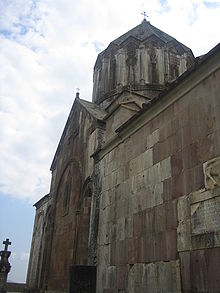| Revision as of 22:39, 19 June 2007 editVartanM (talk | contribs)6,453 edits Undid revision 139304220 by Aramgutan (talk)rv sock← Previous edit | Revision as of 23:00, 19 June 2007 edit undoAramgutan (talk | contribs)14 editsNo edit summaryNext edit → | ||
| Line 1: | Line 1: | ||
| ] | ] | ||
| ] | ] | ||
| The '''Gandzasar monastery''' (]: Գանձասար; ]: ''Xandzasər'') is an ] ] in ], situated in the ] region, near the village of Vank. Gandzasar means ''treasure mountain'' in Armenian |
The '''Gandzasar monastery''' (]: Գանձասար; ]: ''Xandzasər'') is an ] ] in ], situated in the ] region, near the village of Vank. Gandzasar is a compound word, that means ''treasure mountain'' or ''treasure hilltop'' in Middle Persian (from ''gandz'' - treasure) and its derived and influenced languages, such as Armenian and Azerbaijani. On site is the Church of St. John the Baptist (Սուրբ Յովհաննու Մկրտիչ եկեղեցի in ]), which was built between ] and ]<ref>''Artsakh: A Photographic Journey'' by Hrair Khatcherian, p.13. {{OCLC|37785365}}</ref>. The complex is protected by high walls, which have exquisite bas-reliefs on the exterior walls that depict the ], ], and two ministers holding a model of the ] above their heads as an offering to ]. The bas-reliefs have been compared to the elaborate inscriptions of ], and some scholars and historians consider the monastery to represent one of the top masterpieces of ]n architecture. Although the monastery was damaged during the ] and one building, the house of the Father Supieror, was lost, Gandzasar is actively functioning today, and is the seat of the ]. | ||
| Gandzasar was the residence of an |
Gandzasar was the residence of an Caucasian Albanian catholikos from about 1400 to 1816.<ref name="hewsen">{{cite book | last = Hewsen | first = Robert H. | title = Armenia: a historical atlas | year = 2001 | publisher = ] | id = ISBN 0-226-33228-4 | pages = 159 }}</ref> | ||
| Gandzasar is a compound word in ] that means ''hilltop treasure''. <ref name= "bbc2005">Գանձ+ա+սար, Գանձ = Treasure; Սար = Mountain or hilltop</ref> | |||
| ==References== | ==References== | ||
| Line 11: | Line 9: | ||
| ] | ] | ||
| ] | |||
| ] | ] | ||
| ] | ] | ||
| ] | |||
| {{Azerbaijan-stub}} | {{Azerbaijan-stub}} | ||
| {{Armenia-stub}} | |||
| {{euro-struct-stub}} | {{euro-struct-stub}} | ||
| {{OrientalOrthodoxy-stub}} | {{OrientalOrthodoxy-stub}} | ||
Revision as of 23:00, 19 June 2007


The Gandzasar monastery (Armenian: Գանձասար; Azeri: Xandzasər) is an Caucasian Albanian monastery in Nagorno-Karabakh, situated in the Mardakert region, near the village of Vank. Gandzasar is a compound word, that means treasure mountain or treasure hilltop in Middle Persian (from gandz - treasure) and its derived and influenced languages, such as Armenian and Azerbaijani. On site is the Church of St. John the Baptist (Սուրբ Յովհաննու Մկրտիչ եկեղեցի in Armenian), which was built between 1216 and 1238. The complex is protected by high walls, which have exquisite bas-reliefs on the exterior walls that depict the Crucifixion, Adam and Eve, and two ministers holding a model of the church above their heads as an offering to God. The bas-reliefs have been compared to the elaborate inscriptions of Aghtamar, and some scholars and historians consider the monastery to represent one of the top masterpieces of Armenian architecture. Although the monastery was damaged during the Nagorno-Karabakh war and one building, the house of the Father Supieror, was lost, Gandzasar is actively functioning today, and is the seat of the Archbishop of Artsakh.
Gandzasar was the residence of an Caucasian Albanian catholikos from about 1400 to 1816.
References
- Artsakh: A Photographic Journey by Hrair Khatcherian, p.13. OCLC 37785365
- Hewsen, Robert H. (2001). Armenia: a historical atlas. The University of Chicago Press. p. 159. ISBN 0-226-33228-4.
This Azerbaijan-related article is a stub. You can help Misplaced Pages by expanding it. |
This article about a European building or structure is a stub. You can help Misplaced Pages by expanding it. |
This Oriental Orthodox Christianity–related article is a stub. You can help Misplaced Pages by expanding it. |